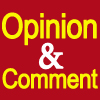 By Pepper Parr
By Pepper Parr
September 26th, 2016
BURLINGTON, ON
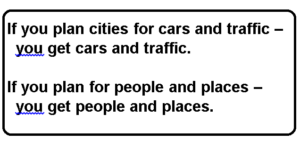 The following is a summary of the “New Directions” city council debated last week. The document in front of them was a draft that was received and filed. It will come back to city council in November, once the team putting the new transportation plan together has had a chance to absorb what council had to say during the three hour meeting.
The following is a summary of the “New Directions” city council debated last week. The document in front of them was a draft that was received and filed. It will come back to city council in November, once the team putting the new transportation plan together has had a chance to absorb what council had to say during the three hour meeting.
We have added comments to each of the following eight new directions.
1 – Align Land Use & Transportation
Land – use decisions including density, mix of uses and quality of urban design contribute to a fabric that supports walking, biking and public transit. Fully integrate land – use and transportation decision-making at every level including policy-making and budgeting to ensure that future decisions facilitate a transportation network that supports intensification.
Two issues with this direction: wasn’t transportation considered when land use decisions were being made? This city council assumes the citizens have bought into the decision to intensify – don’t think that is the case.
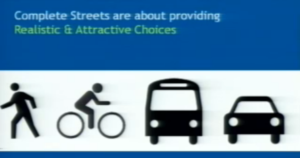 2 – Rethink Streets
2 – Rethink Streets
Abandon the “old” way of thinking, replace the term “road” with “street” and recognize that streets do more than just move automobiles, they are “people places” and have the potential to be key assets in the civic life of our city.
Very true – we are stuck in some old way thinking but changing road to street is not going to do it. If Road is out of tune with the times what are Lines – Guelph Line, Walkers Line – they are part of the city’s genealogy.
Streets are people places but there has to be a reason for people to be on the street
3 – Reprioritize Mobility Choices
Reprioritize decision – making in order to support intensification and allow active and sustainable mobility choices to “catch – up” to the auto and reach an ambitious level of attractiveness in order to realize a true multi-modal city.
This council has committed itself to upgrading its infrastructure and had a ten year + plan to do just that – it will be like pulling teeth from a hen to get the majority to change.
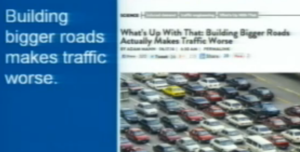
The image was lifted from a presentation given to city council last week
4 – No New Car Capacity
Intensification with further car – oriented design will only result in continued auto-dependency, expensive infrastructure and an overall failure. Confirm that through the intensification strategy, mobility will be facilitated not through increased auto capacity, but by allocating existing space and budget for walking, biking and public transit. Strategic reallocation of existing car capacity for active and sustainable mobility choices.
This is what city council did back in the days when the Orchard was being developed. Not much was made in the way of allowances for parking because people were not going to use cars – there would be a realistic transit system. Council now spends hours discussing with irate citizens whether and where they should be able to park their cars – all three or four of them.
There is a large housing development being built on the North West corner of Walkers Line and Dundas – is anyone suggesting that there be no car capacity in that community? No at the price point they are asking for a single detached home.
5 – Make Walking Delightful
Change the culture, decision-making, policy and budget to make the city rapidly more walkable – achieve the strategic goal of becoming a leader in walkability.
A city council doesn’t have the right to change the culture of a city unless they have a mandate to do so. The culture change is something that is being sprung on people with little of any input from the public so far. There are plans for public input in November – nothing concrete yet.
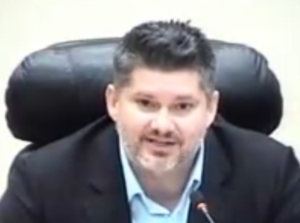
Brent Toderian, planning consultant hired by the city to guide the planning and transportation departments on new directions. He told Council they were going in the right direction.
6 – Make Biking Delightful
Move in a timely way to create a minimum network of safe, connected bike infrastructure with continued network expansion over time. Emphasis on initiatives to build an urban biking culture and achieve the “Gold Standard” for cycling.
Good luck on this one – cycling to work is something a few will do regularly. I suspect cycling is a recreational event for most people in Burlington.
7 – Make Transit Delightful
Support significant and strategic improvement of transit coverage, service and experience in order improve the branding of public transit as an attractive mobility option.
Develop policy to support levels of density that will translate to increased ridership.
There are literally hundreds that would settle for a decent transit schedule – they would scoff at the idea of rising a bus as being delightful.
8 – “Walk the Talk”
Dedicate energy and attention to ensuring that the plan is followed – through. Strategically position the city for successful implementation of the Plan and align budget allocations to the new mode hierarchy.
Great idea – just make sure that there is real public input – not a plan that is put out with the public expected to accept something that has already been decided.
Genuine public education and genuine public involvement.
There is a lot more public discussion needed on this subject – my colleague Joan Little suggests there won’t be a single safe seat on city council if this goes much further. It is going to go a lot further – the city manager and the planner are intellectually committed to this. Council – wait until they get a sense of what the backlash is likely to be before deciding on what they will do.
In the past they have changed bus routes when as little as three people complained.
Related article
Spectator columnist suggests every council seat could be at risk with some of these ideas.















“If you can’t originate at least emulate and hopefully learn something in the process!”
Right on Steve! We are all copying Portland – how did that work out?
https://www.oregonlive.com/opinion/index.ssf/2015/03/portland_has_created_parking_p.html
https://koin.com/2015/08/10/pbot-help-us-solve-portlands-parking-problem/
etc …
Reading the highlights of this consultants report, sure brings home the saying “those that can do-do, those that can’t are consultants or politician”.
Greg and Hans both make very good points.
The attitude of Council and City staff on planning and transportation issues is akin to a parent scolding a disobedient child. Not only is their style pedantic but their overall tone is condescending and frankly, arrogant. I’m sick and tired of being lectured by consultants and our Mayor who berate and demean the rest of us for driving to work and for other purposes.
The average Burlington family is a two-car household. One parent likely commutes by GO train to work in Toronto and drives to the GO Station, and the other probably commutes by car to Oakville, Mississauga, Hamilton or places beyond. Truth is that Burlington has been losing jobs for years, and a significant portion of our working population commute outside the City for high paying employment. When not commuting they are leading hectic lives shuttling kids to soccer practices, running errands, shopping, etc. It would be nice if all those big box stores, shopping facilities and other amenities were aggregated in one spot. Fact is: they aren’t. And by the way: who was it who approved those zoning by-laws and variances to permit all those big box stores to locate on the outer reaches of Appleby Line? You guessed it: Burlington Council.
I commuted by GO Train into Toronto for over 30 years. For most of that time I rode Burlington Transit to the Appleby GO station. Burlington Transit was notoriously unreliable, they had trouble keeping to a schedule, and were invariably late. In winter you could count on adding 5 to 10 minutes each for for your commute.
If this Council and our Mayor want to be really helpful then start focusing on the bigger issues dealing with transportation congestion. By contrast, Mayor Tory today launched an initiative in Toronto that will see dual turning lanes on several major intersections, as well as extended advance greens to a minimum of 30 seconds. Our Mayor should watch the news tonight and maybe he might learn a few things. If you can’t originate at least emulate and hopefully learn something in the process!
I have to agree with your assessment of City Hall. The problem is “top down” management by the City Hall elites–the Mayor, Council, and bureaucrats.
Something is terribly wrong in this city when a Vancouver consultant and other lobby groups have more impact on the decision-making process than do ordinary Burlingtonians. None of these politicians ran for office on a mandate to make these kinds of changes.
And its not enough to say residents will have input into these initiatives. As seen by the New Street fiasco, when citizen input was solicited it was purely window-dressing; I was at the meeting at Bateman. The decision was a fait- accompli; the Cycling Committee (representing .5% of all road users) had far more impact than local residents and car drivers. The local councillor, Dennison, whose ward the lane reductions took effect in, AT NO TIME SOLICITED FEEDBACK FROM HIS CONSTITUENTS. Dennison has always represented the cycling lobby–more elitism.
The key way forward is to make this an election issue in 2018. In my view. we can initiate change by electing a new mayor and new councillors who believe in bottom-up DEMOCRACY.
The best part of this Opinion & Comment article was Pepper’s very insightful comments (in Bold after each of the 8 wishful thinking items) and Pepper was actually the only one that made any sense.
I agree also with Greg, when he says: “Stop pretending we are all idiots that never “thought” of walking.” Burlington wasn’t designed for it and retrofitting may not be do-able at all – it’s simply too late and denying reality won’t change that.
A critical item that I don’t see discussed is the effect of the OMB on this vision wish list. Burlington is at the mercy of the development industry.
Look “transportation” means getting around quickly, easily and cheaply. People are traveling around because of they way you have placed jobs in one area, people in another and shopping in a third. A separation that we are increasing NOT reducing.
This idea that we will keep placing hundreds of thousands of more homes in Burlington and hundreds of thousands of jobs in Toronto and just decide that people need to walk everywhere is insane.
I’m all for increased density so long as parks, recreation, localized business, roads and transit options come with it. I’m all for family apartment buildings surrounded by parks with a pub down the street.
However the city is moving away from all of it. It’s not greener it’s greyer. It’s not easier to move around it’s worse. There are not more parks per person there are less.
It’s not an “attitude” problem that has people diving around, they are just trying to get there kids to a soccer game and get to work and got out to dinner. You want them to drive less, localize more parks, make more localized places for restaurants, etc.
Stop pretending we are all idiots that never “thought” of walking. We can all use google it tells you how long it takes to walk some place.